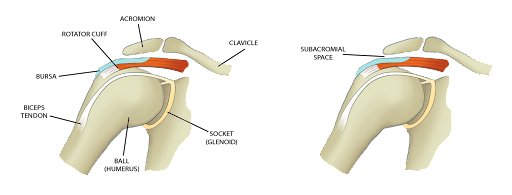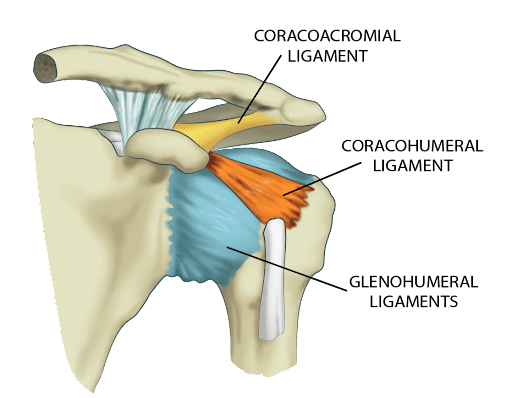Shoulder Tendonitis
Shoulder tendonitis is a painful medical condition that involves the inflammation of the tendons in the shoulder joint. It can involve the rotator cuff tendon as well as the biceps tendon and is typically caused by repetitive overhead motions or sudden trauma.
What Is Shoulder Tendonitis?
A tendon is a thick connective tissue connecting muscle to bone. It functions to transmit the force generated by the muscle contractions to the bones, enabling movement of the associated joint. The rotator cuff and the biceps tendon are the major tendons in the shoulder.
The rotator cuff is composed of four major tendons: supraspinatus, infraspinatus, subscapularis, and teres minor. The rotator cuff tendons provide shoulder stability and facilitate arm movement and are therefore susceptible to injury and degeneration.
Shoulder tendonitis is a common, painful medical condition in which the rotator cuff and/or biceps tendons become inflamed. Shoulder pain is common and is the third leading cause of musculoskeletal complaints at physician office visits. Shoulder complaints account for 4.5 million visits and $3 billion in healthcare costs in the United States annually (1).
Shoulder Tendonitis Symptoms
Symptoms can vary from patient to patient depending upon many factors, including the severity and chronicity of the shoulder tendonitis. The most common symptoms include:
Inability to Hold the Arm in Certain Positions
The rotator cuff allows for shoulder movement in different planes. Examples include overhead and internal rotation. Inflammation of the shoulder tendons can limit such movements in addition to making them painful.
Pain or Tenderness in the Shoulder Area
Pain is the most common symptom and is typically associated with specific movements such as overhead lifting. Patients may also complain of touch tenderness, particularly in the front of the shoulder.
Pain at Night
Nighttime pain is common in shoulder tendonitis for several reasons. Sleeping in certain positions can put pressure on the joint shoulder and tendons, thus aggravating the pain. In addition, decreased movement during sleep may cause the muscles and tendons to stiffen, thereby increasing pain.
Deeper Dive into Symptoms
Shoulder And Neck Pain On Right Side
Shoulder and neck pain on the right side can indicate conditions involving the organs in the right side of your chest and abdomen. If you have right-sided neck and shoulder pain, it must be investigated. This post delves into the possible symptoms, causes, and treatments for this condition.
Read More About Shoulder And Neck Pain On Right SideShoulder Cracking
The Scapula is your shoulder blade. It is a large triangular bone that compromises part of the shoulder joint. The Scapula is positioned over the back chest wall and ribs where it moves in different directions with shoulder movements (1). The Scapula meets with the arm bone (humerus) to form the shoulder joint. It also meets with the clavicle to form the AC joint. Multiple structures attach onto the Scapula which provides important support and movement for the scapulae and shoulder joint (2). These include:- Muscles/Tendons: Multiple muscles attach to the Scapula which include the deltoid, supraspinatus, infraspinatus, triceps, and teres minor.
Read More About Shoulder CrackingShoulder Joint Pain
Shoulder joint pain is the third most common reason that people see their primary care physician (1). It is commonly experienced by people who use their hands overhead a lot, particularly in occupations such as painting and construction. Individuals who train with repetitive overhead movements, such as tennis players, swimmers, and basketball players, are also prone to develop shoulder joint pain. The symptoms and progression of pain in the shoulder joint can vary from person to person, depending on what is causing it. We’ll discuss the causes of shoulder pain, how it is diagnosed, and how it is treated.
Read More About Shoulder Joint PainWhy Does My Shoulder Hurt When I Lift My Arm?
Shoulder pain can be very non-specific, meaning that multiple structures and issues can cause identical pain in the shoulder. Most shoulder examination maneuvers are very limited in their ability to assess exactly what the problem is. With pain when lifting your shoulder, it is critical to take a detailed history, good examination, coupled with imaging to fully understand what is causing the shoulder pain. Many conditions can present with these symptoms
Read More About Why Does My Shoulder Hurt When I Lift My Arm?Common Causes of Shoulder Tendonitis
Shoulder tendonitis is a common medical condition, characterized by inflammation or irritation of the tendons in the shoulder. The most common causes include:
Sports Injuries
Trauma is one of the leading causes of shoulder tendonitis (2). Examples include a direct blow to the shoulder and a fall onto an outstretched arm.
Repetitive or Overuse of Shoulder Tendons
Sports-related trauma is not the only cause of shoulder tendonitis. Individuals who perform heavy lifting and overhead work are susceptible to injury and development of shoulder tendonitis.
Subacromial Impingement Syndrome: (SIS)
The rotator cuff tendons pass through a narrow space in the shoulder that is referred to as the subacromial space. The space is created by the acromion above and the humeral head below (3).
The subacromial space houses several important structures, including the rotator cuff tendons and the subacromial bursa, a fluid-filled space that facilitates smooth movement of the shoulder joint. Structural abnormalities or repetitive overhead activities can create a narrowing of the subacromial space, which in turn can lead to shoulder tendonitis.

Shoulder Instability
Stability of the shoulder joint is critical for maintaining proper function. It provides support and control during various activities, including lifting, reaching, and throwing. The shoulder is stabilized by large ligaments and muscles.
The major ligaments are the superior, middle and inferior glenohumeral, and coracohumeral ligaments. When ligaments are injured or muscles are weak, the humeral head can move superiorly, thereby decreasing the subacromial space. This can lead to tendonitis of the shoulder.

Poor Mechanics
Poor shoulder mechanics can contribute to shoulder tendonitis by placing excessive stress on the tendons of the rotator cuff and other structures in the shoulder joint. When biomechanics are compromised, such as during repetitive overhead motions with incorrect form or through activities that involve improper shoulder positioning, the tendons can become irritated and inflamed.
How to Prevent Tendonitis in the Shoulder
To prevent shoulder tendonitis, it’s important to:
- Warm up before activities, especially exercising, to prepare your muscles
- Strengthen shoulder muscles by gradually increasing the intensity of your workouts to avoid overloading the muscles in your shoulder
- Maintain good posture during activities to reduce strain on the shoulders
- Avoid repetitive overhead movements
- Incorporate rest and recovery into your routine
Who Is at Risk?
As we age, our rotator cuff and biceps tendons become less flexible, thereby increasing the risk of shoulder tendonitis.
Other risk factors include:
- Participating in sports that involve repetitive motions such as baseball, swimming, and tennis
- Occupations that involve repetitive overhead movements such as painters, movers, and roofers
- Poor shoulder mechanics
- Not stretching before being physically active
When to Call Your Doctor
Persistent shoulder pain or reduced range of motion that does not respond to conservative care requires evaluation by your primary care or regenerative medicine physician.
Diagnosis and Examination
Diagnosing shoulder tendinosis typically involves a combination of medical history review, past surgical history, physical examination, and diagnostic imaging.
- Medical history: Important details will include duration of pain, location, severity, aggravating and alleviating factors, and treatment to date. Did trauma precede the onset of pain and restriction in range of motion? Is there a history of shoulder instability characterized by subluxations or dislocations?
- Past surgical history: Have there been any prior shoulder surgeries and, if so, what were the outcomes? Is there any history of neck surgeries and, if so, what were the indications? Was there arm and shoulder weakness that prompted neck surgery? What were the outcomes?
- Physical examination: A comprehensive examination of the shoulder is required to evaluate the range of motion, areas of pain, strength, and neurologic function. Specific tests such as the Neer and Hawkins tests may be performed to evaluate impingement.
- Imaging studies: Imaging is often used to evaluate shoulder tendinosis in addition to ruling out other potential causes of shoulder pain and restriction. Common imaging includes:
- X-rays: Inexpensive, readily available tests that can identify bone abnormalities such as bone spurs and shoulder arthritis. However, X-rays CANNOT evaluate shoulder tendons.
- Ultrasound: Powerful, in-office imaging that can provide real-time visualization of the shoulder tendons, ligaments, and other soft tissue, including nerves. Unlike X-rays or MRIs, ultrasound can evaluate shoulder stability. Patients can also be put through provocative maneuvers under ultrasound guidance to help identify sources of pain.
- Magnetic resonance imaging (MRI): Advanced imaging study that uses a powerful magnetic field and radio waves to create detailed 3D images of bone and soft tissue. MRIs can evaluate tendons, ligaments, nerves, muscles, and joint cartilage.
How Will Your Doctor Determine the Best Course of Action?
Treatment options will vary depending on many factors, including age, overall health, current medications, response from treatment, the severity of the tendinosis, and the presence or absence of tendon tears. When appropriate, conservative care should always be first-line treatment.
Can Complications Occur if Left Untreated?
Tendonitis in the shoulder is a painful medical condition that involves the inflammation of the shoulder tendons, including those that attach to the rotator cuff and biceps. Pain and restriction in range of motion that is not responsive to conservative care requires evaluation. If ignored or left untreated, significant problems can occur. The most common include:
- Progression of tendonitis to tendon tears, which may require surgery
- Escalation of pain, which can become chronic
- Erosion of sleep and well-being
- Reduced shoulder range of motion
- Diminished shoulder function
- Possible progression to frozen shoulder syndrome (4)
Shoulder Tendonitis Treatment Options
Treatment options for shoulder tendonitis encompass a spectrum of approaches aimed at alleviating pain, reducing inflammation, and restoring function to the affected shoulder. Treatment options vary from patient to patient, depending upon medical history, current medications, severity of tendonitis, response to rest, and access to medical care. As noted above, when appropriate, conservative care should always be the first line of treatment.
Natural Remedies You Can Try at Home
Natural remedies that can be done at home to relieve symptoms of shoulder tendonitis:
- Apply ice packs to the affected area for pain relief and inflammation reduction.
- Perform gentle shoulder stretches to improve flexibility and reduce stiffness.
- Consider using a shoulder brace for added support during activities.
- Rest the shoulder to allow time for healing, and avoid activities that worsen the pain.
Non-Surgical Options
Non-surgical treatment options for shoulder tendonitis can include physical therapy, non-steroidal anti-inflammatory drugs (NSAIDs), corticosteroid injections, and ultrasound-guided procedures. These methods are effective in reducing pain and inflammation, but they may have limitations in severe cases.
Physical therapy helps improve flexibility and strength, NSAIDs offer pain relief, corticosteroid injections reduce inflammation, and ultrasound-guided procedures assist in targeted treatment.
However, side effects like gastrointestinal irritation from NSAIDs, temporary pain increase after injections, and limited long-term relief in some cases should be considered. In severe or persistent cases, surgical intervention may be necessary for optimal recovery.
Surgery
Severe shoulder tendonitis with impingement that does not respond to conservative care may require surgical evaluation and treatment; however, this is not common.
There Is a Non-Surgical Alternative to Treat This Condition
Platelet-rich plasma (PRP) and bone marrow concentrate are viable treatment options utilized at the Centeno-Schultz Clinic in the treatment of shoulder tendonitis. Both treatment options increase blood flow and can potentially accelerate healing.
Our randomized control study published in 2020 demonstrated that bone marrow concentrate and platelet-rich plasma treatments were superior to exercise therapy in the treatment of rotator cuff tendon tears (6). PRP and bone marrow concentrate enable patients to avoid dependency on narcotics and the risks and complications associated with orthopedic surgery.
Don’t Ignore Your Symptoms – Get Yourself Checked Today
Shoulder tendonitis is a common, painful condition that involves the inflammation of the tendons in the shoulder joint. Common symptoms include the inability to hold the arm in certain positions, pain, and restriction in the range of motion.
Causes of shoulder tendonitis include trauma, repetitive or overuse, subacromial impingement, and shoulder instability. Persistent pain and shoulder range of motion restriction that do not respond to conservative treatments warrant further evaluation.
The diagnosis of shoulder tendonitis includes history, physical examination, and, in most cases, imaging. At the Centeno-Schultz Clinic, in-office ultrasound is also utilized to evaluate shoulder injuries including tendinitis.
If left untreated, shoulder tendonitis can progress to tendon tears, chronic pain, compromised function, and possible frozen shoulder.
PRP and bone marrow concentration are viable treatment options allowing patients to avoid dependence on narcotics and the risks and complications associated with orthopedic surgeries.
Are you experiencing these symptoms and want to find out what’s causing your discomfort? Get yourself checked from the comfort of your own home today.

John Schultz, MD
John R. Schultz M.D. is a national expert and specialist in Interventional Orthopedics and the clinical use of bone marrow concentrate and PRP for orthopedic injuries. He is board certified in Anesthesiology and Pain Medicine and underwent fellowship training. Dr. Schultz has extensive experience with same day as well as culture expanded bone marrow concentrate and sees patients at the CSC Broomfield, Colorado Clinic, as well the Regenexx Clinic in Grand Cayman. Dr. Schultz emphasis is on the evaluation and treatment of thoracic and cervical disc, facet, nerve, and ligament injuries including the non-surgical treatment of Craniocervical instability (CCI).
Other Resources for Shoulder Tendonitis
-
10 Best Shoulder Physical Therapy Exercises to Ease the Pain
Physical therapists often recommend specific exercises to alleviate shoulder pain, recognizing their effectiveness in both treating and preventing shoulder issues. These exercises, designed to enhance strength, flexibility, and mobility, can be a key component of a pain management strategy. Moreover, the ability to perform these exercises at home makes them a convenient option for patients…
-
KT Tape For Hamstring Tendonitis
Hamstring tendinosis is a condition that causes pain and inflammation in the hamstring tendons. The hamstring tendons are the tough bands of tissue that attach the hamstring muscles to the bones in the back of the thigh. Hamstring tendinosis is a degenerative condition, meaning that it is a condition that causes the tissue to break…
-
Treatment For A Torn Rotator Cuff Without Surgery: Exploring Your Options
Welcome to the Guide for Rotator Cuff Tear Relief Without Surgery. Rotator cuff injuries affect millions of people globally (1). The incidence vastly increases with age. Irrespective of the cause, there are many treatment options for rotator cuff injuries apart from surgery. If you want to avoid rotator cuff surgery, you’re in the right place!…
-
7 Untreated Whiplash Symptoms You Need to Watch For
Whiplash is a significant injury that is commonly associated with motor vehicle accidents. Dr. Schultz discusses what whiplash is, the structures that can be injured, the 7 untreated whiplash symptoms that you need to watch for, and the major long-term consequences of not treating whiplash symptoms.
-
KT Tape Shoulder: Facts You Need to Know!
KT Tape is used extensively for shoulder injuries. Dr. Schultz discusses what KT tape is, what it is used for, how it helps shoulder pain, whether it really works and a better solution.
-
5 Causes of Numbness After Carpal Tunnel Surgery
Carpal Tunnel Syndrome is a medical condition that causes pain and numbness in the hand and fingers. It arises from compression of the median nerve. Dr. Schultz discusses the 5 major causes of numbness after Carpal Tunnel Surgery, their causes, and a novel, nonsurgical treatment option for carpal tunnel syndrome.
-
Shoulder Pain from Lifting Weights
Lifting weights has many benefits. Shoulder pain from lifting weights can arise from many sources. Dr. Schultz discusses some of the unrecognized causes of shoulder pain and treatment options.
-
Rotator Cuff Surgery Recovery Timeline
If you’re considering surgery for a rotator cuff tear, an important thing to consider is how long the recovery will take and what’s involved in the procedure. But let’s begin with the rotator cuff itself. What Is the Rotator Cuff? The rotator cuff is a group of four muscles and tendons that stabilize the ball…
-
What to Expect from Shoulder Replacement Recovery
Many patients avoid shoulder replacement because they are concerned about shoulder replacement recovery. So what should you expect? How long does it take to recover from a shoulder replacement? Is shoulder replacement surgery successful? Let’s dig in. What is Shoulder Replacement Surgery? Shoulder replacement surgery, also known as shoulder arthroplasty, can be a transformative procedure…
References
- Oh LS, Wolf BR, Hall MP, Levy BA, Marx RG. Indications for rotator cuff repair: a systematic review. Clin Orthop Relat Res. 2007 Feb;455:52-63. doi: 10.1097/BLO.0b013e31802fc175. PMID: 17179786.
- Weiss LJ, Wang D, Hendel M, Buzzerio P, Rodeo SA. Management of Rotator Cuff Injuries in the Elite Athlete. Curr Rev Musculoskelet Med. 2018 Mar;11(1):102-112. doi: 10.1007/s12178-018-9464-5. PMID: 29332181; PMCID: PMC5825345.
- Dhillon KS. Subacromial Impingement Syndrome of the Shoulder: A Musculoskeletal Disorder or a Medical Myth? Malays Orthop J. 2019 Nov;13(3):1-7. doi: 10.5704/MOJ.1911.001. PMID: 31890103; PMCID: PMC6915323.
- Page P, Labbe A. Adhesive capsulitis: use the evidence to integrate your interventions. N Am J Sports Phys Ther. 2010 Dec;5(4):266-73. PMID: 21655385; PMCID: PMC3096148.
- Wernecke C, Braun HJ, Dragoo JL. The Effect of Intra-articular Corticosteroids on Articular Cartilage: A Systematic Review. Orthop J Sports Med. 2015 Apr 27;3(5):2325967115581163. doi: 10.1177/2325967115581163. PMID: 26674652; PMCID: PMC4622344.
- Centeno C, Fausel Z, Stemper I, Azuike U, Dodson E. A Randomized Controlled Trial of the Treatment of Rotator Cuff Tears with Bone Marrow Concentrate and Platelet Products Compared to Exercise Therapy: A Midterm Analysis. Stem Cells Int. 2020 Jan 30;2020:5962354. doi: 10.1155/2020/5962354. PMID: 32399045; PMCID: PMC7204132.